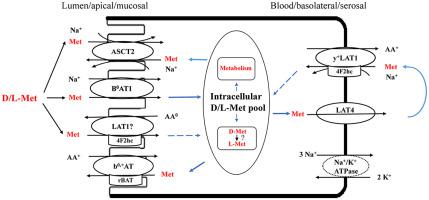Comparative Biochemistry and Physiology A: Molecular & Integrative Physiology ( IF 2.1 ) Pub Date : 2021-01-20 , DOI: 10.1016/j.cbpa.2021.110908 Van Pham Thi Ha To 1 , Karthik Masagounder 2 , Matthew E Loewen 1

|
DL-methionine (DL-Met) and its analogue DL-2-hydroxy-4-(methylthio) butanoic acid (DL-methionine hydroxyl analogue or DL-MHA) have been used as nutritional supplements in the diets of farmed raised animals. Knowledge of the intestinal transport mechanisms involved in these products is important for developing dietary strategies. This review provides updated information of the expression, function, and transport kinetics in the intestine of known Met-linked transporters along with putative MHA-linked transporters. As a neutral amino acid (AA), the transport of DL-Met is facilitated by multiple apical sodium-dependent/−independent high−/low-affinity transporters such as ASCT2, B0AT1 and rBAT/b0,+AT. The basolateral transport largely relies on the rate-limiting uniporter LAT4, while the presence of the basolateral antiporter y+LAT1 is probably necessary for exchanging intracellular cationic AAs and Met in the blood. In contrast, the intestinal transport kinetics of DL-MHA have been scarcely studied. DL-MHA transport is generally accepted to be mediated simply by the proton-dependent monocarboxylate transporter MCT1. However, in-depth mechanistic studies have indicated that DL-MHA transport is also achieved through apical sodium monocarboxylate transporters (SMCTs). In any case, reliance on either a proton or sodium gradient would thus require energy input for both Met and MHA transport. This expanding knowledge of the specific transporters involved now allows us to assess the effect of dietary ingredients on the expression and function of these transporters. Potentially, the resulting information could be furthered with selective breeding to reduce overall feed costs.
中文翻译:

跨肠道的蛋氨酸和蛋氨酸羟基类似物补充剂的关键转运蛋白:我们目前所知道的以及可以学到的促进动物营养的知识
DL-蛋氨酸 (DL-Met) 及其类似物 DL-2-羟基-4-(甲硫基)丁酸(DL-蛋氨酸羟基类似物或 DL-MHA)已被用作养殖动物饮食中的营养补充剂。了解这些产品中涉及的肠道转运机制对于制定饮食策略很重要。本综述提供了已知 Met 连接转运蛋白以及推定的 MHA 连接转运蛋白在肠道中的表达、功能和转运动力学的最新信息。作为一种中性氨基酸 (AA),DL-Met 的转运受到多种顶端钠依赖性/-非依赖性高-/低亲和力转运蛋白的促进,例如 ASCT2、B 0 AT1 和 rBAT/b 0,+在。基底外侧运输很大程度上依赖于限速单向转运蛋白 LAT4,而基底外侧反向转运蛋白 y +LAT1 可能是交换血液中细胞内阳离子 AA 和 Met 所必需的。相比之下,DL-MHA 的肠道转运动力学几乎没有研究。DL-MHA 转运一般被认为是由依赖质子的单羧酸转运蛋白 MCT1 介导的。然而,深入的机制研究表明,DL-MHA 的转运也是通过顶端单羧酸钠转运蛋白 (SMCT) 实现的。在任何情况下,依赖质子或钠梯度将因此需要能量输入用于 Met 和 MHA 传输。对所涉及的特定转运蛋白的这种不断扩展的知识现在使我们能够评估饮食成分对这些转运蛋白的表达和功能的影响。潜在地,所得信息可以通过选择性育种得到进一步发展,以降低总体饲料成本。











































 京公网安备 11010802027423号
京公网安备 11010802027423号